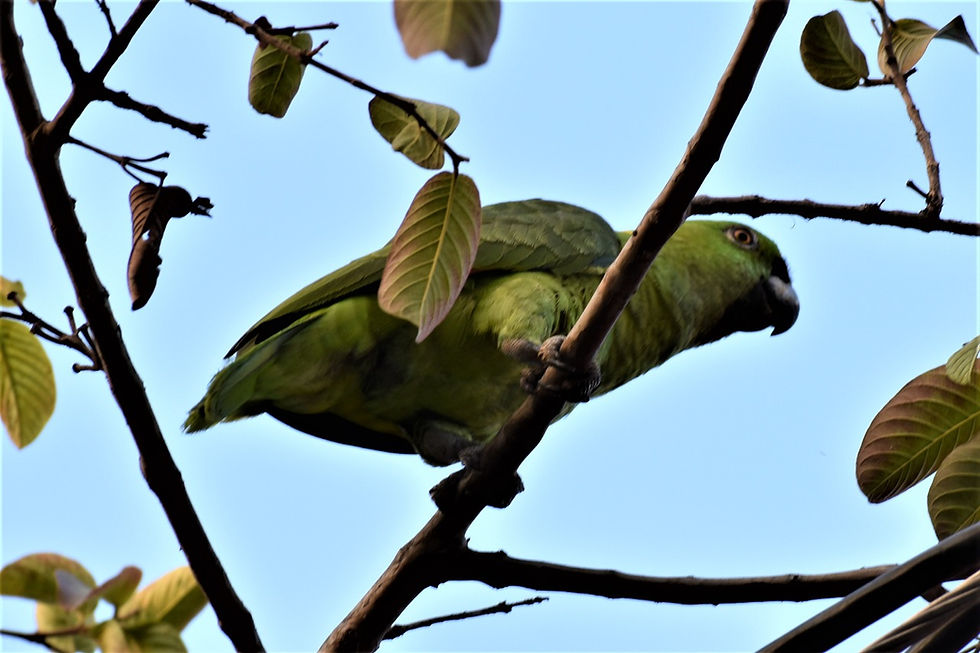Urban Trophic Networks: House Geckos, Mosquitoes, and Public Health
- Diego Ardón

- Aug 10
- 4 min read
You’ve probably seen them recently—motionless on your wall or hunting insects near a lightbulb. The common house gecko (Hemidactylus frenatus) is a familiar sight in most Honduran homes (Figure 1). Native to Southeast Asia, it has spread to nearly every corner of the world. It’s a classic example of an invasive species, and new studies suggest it could be altering food chains and having consequences for public health.

Figure 1. House gecko (Hemidactylus) showing signs of tail autotomy.
What Is a Trophic Network?
A trophic network (or food web) is the system of “who eats whom” within an ecosystem. We might think that understanding ecological concepts requires venturing into mountain ranges or rainforests like La Mosquitia—but in reality, we can observe ecological interactions daily in our own homes. Today, we’ll look more closely at a study from Thailand—where the house gecko is native—to learn about trophic cascades (Figure 2).
A trophic cascade refers to the effect that the population of one species can have on other species at different levels of the food chain, sometimes indirectly. If an apex predator disappears, the animals it used to consume may multiply unchecked, potentially wiping out the plant populations they feed on.

Figure 2. Diagram of the food chain between geckos, spiders, and mosquitoes, and how it can experience a trophic cascade in the absence of the apex predator. Adapted from Weterings et al. 2019.
Geckos and Mosquitoes in the City
The authors of the aforementioned study propose, based on an interesting ecological observation, that the presence of house geckos in non-native countries may be an important factor in the number of dengue cases. Researchers observed that house geckos and mosquitoes are part of the same food web. Mosquitoes are mainly controlled by predators such as spiders and geckos. However, if we’ve been observant, we know that house geckos usually hunt at night and near artificial light sources, but the main species responsible for spreading diseases like dengue and chikungunya—the infamous Aedes aegypti mosquito—is diurnal. This means that the presence of house geckos doesn’t help control the vector of these diseases. The authors suggest that invasive house geckos in places like Honduras could actually contribute to higher incidence of these diseases by feeding on the true natural controllers of mosquitoes—spiders.
The researchers collected data on the presence of house geckos in each country and classified them as native or invasive. They also gathered confirmed dengue case counts for each country over a 25-year period, along with data to test alternative explanations such as human population density, temperature, vegetation cover, and percentage of urbanization. Statistical analyses indicated that countries with house gecko invasions have higher per capita dengue infection rates than countries where the gecko is native or absent. Dengue incidence also appears to be higher in countries where the introductions occurred before 1975—assuming that this has given house geckos enough time to become fully established. Temperature and the number of gecko species were also related to dengue incidence, while countries with higher health expenditure showed lower incidence.
Should We Be Worried?
Not necessarily. Many factors are linked to higher incidence of these tropical diseases. We can’t dismiss the effects of increasing human population density, urbanization, deforestation, and climate change. It’s unrealistic to point to a single cause. Also, this is a correlational study—it does not necessarily prove cause and effect. However, it does shed light on urban ecosystems and how little we know about them.
Urban environments are also changing rapidly. In their natural habitat, house geckos are regulated by a relative—the tokay gecko (Gekko gecko, Figure 3). This larger and more common gecko, especially in forested regions, helps control house gecko populations, allowing spider populations to remain healthy and keep disease-carrying mosquitoes in check. When a species leaves its native habitat and establishes itself in a new territory, it often experiences release from predation pressure. In the case of the house gecko who possesses adaptations to live near humans, such as hunting around artificial lights, arriving in places like Honduras equals release from its natural predator, the tokay gecko, which evolved over millions of years sharing a micro-niche and keeping house geckos in balance. The rapid adaptation of the house gecko to this new environment not only puts it in direct competition with native geckos but also threatens to disrupt the balance of natural food webs.

Figure 3. The tokay gecko (Gekko gecko), a native controller of house geckos in Southeast Asia. © Pumpkin Sky 2017
What Can We Do?
We shouldn’t take these findings as a call to eliminate house geckos. They may still provide some mosquito control, and removing them at this point could be counterproductive. This study simply reminds us how complex and fascinating urban ecology can be—and how it can have direct consequences for human society.
If you’re a student, researcher, or just someone curious about the natural world, start by observing these interactions at home. What are house geckos eating? Are there mosquitoes in spider webs? Remember—ecology is happening all around you.
Follow us on social media:
Instagram: @Honduras_Neotropical
Facebook: @HondurasNeotropical
By: Diego Ardón, Biologist
References
Weterings R, Barbetti M, y Buckley HL. 2018. Hypothesis: Do invasive house geckos exacerbate dengue fever epidemics? Biological Invasions doi: https://doi.org/10.1007/s10530-019-02066-x
Weterings R, Umponstira C, Buckley HL. 2018. Landscape variation influences trophic cascades in dengue vector food webs. Science Advances 4:9





Comentários